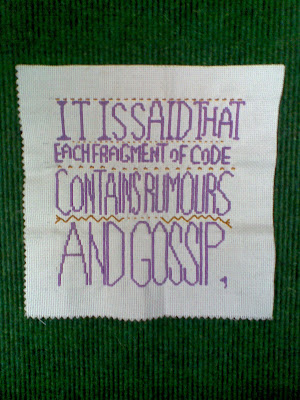24 - 30 January 2009
12.00 – 17.00 daily
Vernissage: Friday 23rd January 4-6pm
Syjunta (GYRMBC): Tuesday 27th January 2-4pm
Syjunta (Yarn): Thursday 29th January 2-4pm
HUMlab Syjunta is an intervention of patterned code and encoded craft into the HUMlab interdisciplinary digital humanities research lab at Umeå University, initiated as part of my research fellowship. The exhibition will present some exisitng OSE artworks (Iain Clark, Paul Grimmer, Clare Roddock, Lisa Wallbank, and James Wallbank) alongside new works in progress created in HUMlab. These will include the collaborative HUMlab GYRMBC Tent, and the collectively stitched Yarn text quilt. Individual works include Suzanne Martin’s Knitted Pattern flat screen cover, Stephanie Wuschitz’s Wireless Women, and Haishu Zhang’s meticulously embroidered HUMlab logo.
HUMlab Syjunta sewing circles will bring together HUMlab html users to stitch the RGB and CMYK hexadecimal colour codes onto the GYRMC tent, and invite the Yarn stitchers to sew their embroidered texts into a single patchwork quilt.
The one-person GYRMBC (Get Your Rabbits Mated Before Christmas) Tent has been created by HUMlab workers to illustrate the combination of RGB and CMYK colour sequences, and to recognise the need for individual creative space alongside the opportunity to collaborate with others.
During November 2008 the Open Source Embroidery Fika workshops at the Fine Art School and HUMlab inspired the stitching of the Raqs Media Collective’s definition of ‘Yarn’ (2003), which describes the metaphorical and material quality of threads, yarn and cables, and how they carry stories through weaving, stitching and bandwidth.
During the HUMlab Syjunta exhibition, I will be embroidering the script for the Patchwiki interface onto the back of the patchwork, so do pop by to say hello.
It's also a great sneak preview of some of the works in progress which will form part of the major Open Source Embroidery exhibition presented at BildMuseet, June 7th – September 6th 2009.
 Today was the last HUMlab Syjunta workshop in Sweden, and several people came to finish their patches. They were posted on the design board next to patches from the USA (see Amanda Thackray's patch pictured here) and the UK (thanks to Abi Gibbens and Alex Hodby).
Today was the last HUMlab Syjunta workshop in Sweden, and several people came to finish their patches. They were posted on the design board next to patches from the USA (see Amanda Thackray's patch pictured here) and the UK (thanks to Abi Gibbens and Alex Hodby).